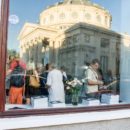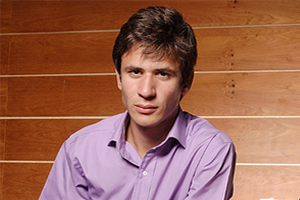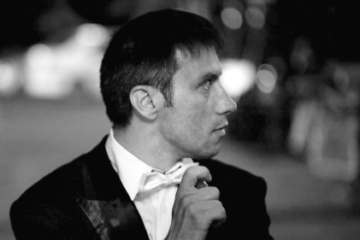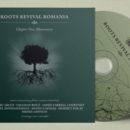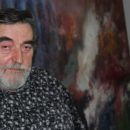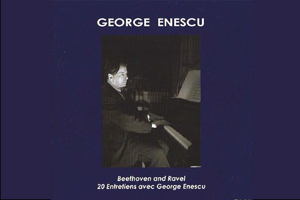
Meloclassic publică Enescu
An outstanding event in the 2013 musical world was the emergence of the Meloclassic label aiming to publish unusual recordings. Most of these recordings are live, with musicians who made a mark on the musical history of the last century. Besides the legendary names known to music lovers and found even today in the disc shops (Wilhelm Backhaus, Wilhelm Kempff, Clara Haskil, Arthur Grumiaux, Yehudi Menuhin, Lola Bobescu etc.), some other artists are also published, artists whose name circulates only around the collectors` circles, but who used to be true stars of classical music (Guila Bustabo or Alexander Uninsky, who had played in 1936 also in Bucharest, Erich Röhn or Branka Musulin).
The recordings, excellently re-mastered by Lynn Ludwig, are not only for collectors, but also for all music lovers with an interest in the past musical life. The applauds and the broadcaster`s speech were preserved in an attempt to recreate, even if only vaguely, the mood of the concert halls or of the radio studios. The 79 titles that were published so far are divided in a few categories: pianists, violinists, cello players, quartets, and conductors.
Presently, the CDs can be purchased only from the Meloclassic website: www.meloclassic.com. One of the remarkable works of this label is a double CD containing unusual recordings, unknown pieces of George Enescu that are missing even from the great musician`s erudite discographies.
The first CD contains three pieces. The first is Sonata No. 7 in c minor op. 30, No. 2 for violin and piano by Beethoven recorded on the 17th of June 1948 in the old hall of the Paris Conservatory, with piano by Georges de Lausnay. At 67 years old, Enescu no longer had the ’20s or ’30s technique, as we know it from the recordings of that time, we can sense an exhausted fiddlestick, a certain insecurity of the left hand, but we can recognize the extraordinary ravishing tone and the personal rubato.
In those times, the critic Marc Pincherle was observing this side of Enescu`s art: “No sound is similar to his – warm, talkative, sometimes it is like a bit harsh background, sometimes it is sad and oddly moving”. The other pieces on the disc are Septet in E flat, op. 20 by Beethoven and Introduction and allegro for harp, flute, clarinet and cords quartet by Ravel, both recorded on the 1st of March 1951, in the same hall of the Conservatory. Enescu plays together with the professors of the Conservatory, and their names were important at that time, yet they are hardly known today.
It is worth remembering of the fagot player Fernand Oubradous, flautist Gaston Crunelle (Jean Pierre Rampal`s and James Galway`s professor), clarinet player Ulysse Delécluse and harp player Pierre Jamet.
The Second CD (produced as an mp3) contains twenty conversations with Enescu produced by Bernard Gavoty for the French Radio and represents the basis of the book The Memories of George Enescu, published in Paris in 1955 and translated to Romanian in 1982. The conversations were recorded at Enescu`s home, rue Clichy, in 1951 and 1952, and the five and a half hours were aired between the 25th of January and the 6th of June 1952.
With humor and nostalgia, Enescu talks about the childhood he spent in Northern Moldavia, about his studies in Vienna where he had listened to Brahms, about his coming in Paris and about his musician friends (Jacques Thibaud or Pablo Casals), about meeting his beloved disciple (Yehudi Menuhin), about his violinist career and the torments of his life as a composer.
It is an Enescu full of life, who sings – or rather hums – Romanian doinas and horas, pieces of the Danube Waves, OEdip, Wagner, Brahms, Beethoven`s quartets, he plays the violin and the piano (a few bars from an opera he wrote an the age of five), he laughs, gets excited and becomes nostalgic now and then.
The surprises on violin George Enescu continue. The same Meloclassic label will publish at the end of this year another two recordings with the violinist, discovered a few months ago in the archives of the French Radio: Johann Sebastian Bach, Sonata No. 2 for violin and piano in A, BWV 1015 and Sonata No. 4 for violin and piano in C, BWV 1017. In both sonatas, there is Céliny Chailley-Richez playing the piano; she has accompanied Enescu at his recitals for several decades.
If a foreign label, recently set up, had succeeded in publishing such documents on George Enescu, maybe it is not impossible for Romania to try and edit the complete series of Bach concerts for one or several pianos, conducted by Enescu at the beginning of the `50s.
We are also looking forward to the publishing of the Brandenburg concert No. 5 in D, BWV 1050, and of the Concert for two flutes and orchestra in F, BWV 1057, with Céliny Chailley-Richez
playing the piano, Christian Ferras the violin, Jean-Pierre Rampal and Gaston Crunelle playing the flute. Plus, the American archives have discovered a tape containing the Concert for violin and orchestra by Brahms, with Enescu playing the violin but no label house wished to publish it in these ten years after its finding. But there are also several recordings with Enescu as conductor which have not yet been produced on a CD: Prelude to the afternoon of a faun by Debussy, Pavana for a late infanta by Ravel, Fileuses from Pelléas et Mélisande de Fauré, Second Simphony by Robert Schumann etc. Likewise, we can remind of the live recordings kept in the Romanian Radio. All of these are waiting for a serious and generous



